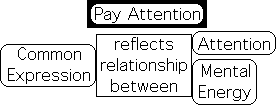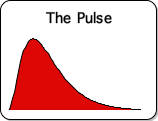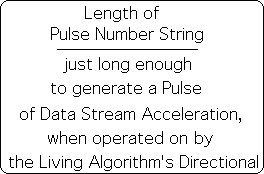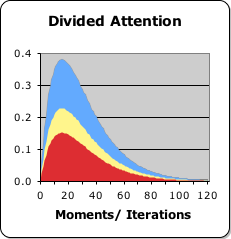Have you ever wondered why we have a hard time concentrating on a task or conversation when we are in pain or worried about the future? Could it be that our molecules or neurons are fighting with each other? Is the reason due to genetics or perhaps a random occurrence without any significance? Or is it possible that this negative impact upon Attention is related to the way we digest information?
The following article explores last alternative – Divided Attention from the perspective of Information Dynamics.
Section Headings
- Competition between Primary & Secondary Attention
- Definitions: Significant, Insignificant & No Attention
- Quantity of Physical & Mental Energy is Fixed, i.e. a Constant.
- Sustained Attention, Data Stream Acceleration, Number Strings & the Ideal Pulse
- The Mathematics of Attention
- The Mathematics of Divided Attention
Competition between Primary & Secondary Attention
Does Divided Attention have a negative impact upon achieving our full potentials? If so, what does Information Dynamics theory reveal about the potential mechanisms behind Divided Attention? The intent of this article is to propose some answers to these questions.
There are two types of split attention - Shifting Attention and Divided Attention. We examined the patterns of correspondence between Information Dynamics and Shifting Attention in the prior article.

With Shifting Attention, the individual's focus alternates so rapidly from topic to topic that 'memory consolidation' doesn't occur. Since 'memory consolidation' is the basis of critical thinking, Shifting Attention should be avoided when possible.

Although a type of split Attention, Divided Attention has entirely different features. Instead of shifting from topic to topic, Divided Attention is characterized by a simultaneous focus upon 2 or more types of Experience.

To gain a better understanding, let us break this phenomenon into 2 parts: the Primary and Secondary Focus of Attention.
The Primary Focus of Attention could consist of myriad types of experience. Following are some typical ones: conversation, entertainment, a sensory experience such as dinner, or even a creative, problem-solving task. This list is partial.

The Secondary Focus of Attention would be a background experience that the individual might not even be aware of. A partial list includes pain, emotional concerns such as worry, standard biological concerns such as hunger, and even the possibility of reward. A Secondary Focus could also concern social relationships with family, friends and workmates.

In each of these cases, the Secondary Focus of Attention is akin to a background noise that the individual is more or less aware of. A nagging pain, concerns about the future, or even the need to urinate would be common examples of this type of Attention. Most of us would consider these distractions to the Prime Focus of Attention.
When tooth pain or an earache becomes too severe, the negative impact upon our ability to pay attention is obvious. When a young child is hyperactive and needs attending to, it impairs the mother's ability to have a quality conversation with a friend. When financial concerns are overwhelming, it is hard to focus upon relationships or even a job. If the Secondary Focus of Attention is extreme enough, it can even take over and become the Prime Focus.
These examples provide clear-cut evidence of the negative impact of the Secondary Focus upon the Prime Focus. We imagine that less severe examples would have a similar though lessened effect upon our ability to pay attention.
![]()
Why does Attention seem to compete in this fashion? Or why would Divided Attention diminish ideal potentials?
The intent of this article is to suggest an answer to this question from the perspective of the Information Digestion Model. According to this model, living systems have a similar relationship to food and information. Just as Body requires and digests food, Mind requires and digests information. This dual digestion process enables Life to fulfill potentials. Information is digested via the Living Algorithm. Attention is Mind's avenue for digesting information.
Definitions: Significant, Insignificant & No Attention
What type of Attention are we talking about?
Obviously, there are many examples where we do things simultaneously without any seemingly adverse effects. We walk and talk. Background music adds a nice touch to a productive experience without detracting from the result. We breathe and digest food at the same time. Is there a difference between these different types of experiences? If so, what is it?
For the purposes of this discussion, let us first define Attention in the Information Dynamics environment. Attention is defined as the conscious expenditure of mental energy to digest information. Due to the digestion process, mental energy is issued in discrete chunks, rather than continuously.
Attention only occurs while we are conscious. When we are asleep, Attention shuts down. Although information continues to be digested while we slumber, residual mental energy from the conscious state drives unconscious cognition. In brief, Conscious Attention determines where we spend our mental energy.

The common expression 'Pay Attention' reflects this relationship between Attention and Mental Energy. Under this metaphor, we choose how we spend our mental energy, just as we choose how we spend our money. Just as we pay money for things, we pay Attention for a cognitive Experience.

The activities of our Prime Focus, such as problem solving, a conversation, and sensory event, all seem to require a significant expenditure of mental energy of Attention to generate a cognitive Experience.
The same holds true of our Secondary Focus. Anxiety, pain, hunger and young children also seem to demand significant mental energy, even though sometimes nothing can be done. When we feel physical or emotional pain, it is a call for potential action to relieve the distress. When our bodily requirements arise to consciousness, they demand our Attention to fulfill our basic biological needs. Each of these cases demands the mental energy of Attention to attend to some kind of problem or potential problem.
In other words, the Prime Focus and Secondary Focus of Attention both require a significant expenditure of mental energy.

In contrast, if a behavior is relatively automatic, i.e. hardwired, we suggest that an insignificant amount of Conscious Attention is required. For instance, walking, breathing, digesting food and driving a car can occur with only a minimal amount of mental energy.

Under this system, Attention only spends mental energy in the conscious state, not the unconscious state of sleep. Sleep could be called the state of No Attention.
![]()
This discussion only concerns the competition between the different types of Attention that call for a 'significant' amount of focused mental energy required for information digestion.
Quantity of Physical & Mental Energy is Fixed, i.e. a Constant.
If mental energy were unlimited, then there would be no competition between the varieties of focus. Pain and/or worry would have no impact upon our cognitive abilities. If there is competition, as there seems to be, then mental energy must be limited in some fashion.
For the purposes of this discussion, we will assume that the amount of mental energy available for Attention is a fixed commodity. In similar fashion, the amount of our body's physical energy is also fixed. Neither is unlimited.
This energy limitation is yet another congruence between the informational and material components of living systems. In contrast, energy is conserved in closed material systems. Particulate matter goes on forever without a break. Atoms never run out of energy. A significant difference between living systems and exclusively material systems is their relationship to energy.
0. Let's see what the implications are if we assume that the mental energy of Attention is a constant. More specifically, let's assume that Attention expends a set amount of mental energy (a quanta) with each iteration of the Living Algorithm's digestion process.
![]()
1. Let A represent the total Attention. Let A1 equal the Prime Focus of Attention, while A2 equals the Secondary Focus.

2. If the total mental energy of Attention is fixed, then the following relationship holds.
![]()
3. For instance, if we assign a value of '1' to total Attention, then the following relationship would also be true.
![]()
Sustained Attention, Data Stream Acceleration, Number Strings & the Ideal Pulse
How does Attention fit into the mathematics of Information Dynamics? Let's start the discussion with a verbal description of the process.
The Living Algorithm generates all the rates of changes, i.e. derivatives, of each moment in a data stream. According to the Information Dynamics theory, Attention is only attracted to one of these derivatives – Data Stream Acceleration. The reason is straightforward. Attending to Data Stream Acceleration acts as a Random Filter. Organized data streams exhibit a sustained acceleration, while random data streams do not. In contrast, there is not a significant or recognizable difference between the velocities of random and organized data streams. (For a more complete development of this topic, see Attention: a Filter of Random Signals).
![]()

Due to its significance to Attention, let us review some of the features of Data Stream Acceleration. The Acceleration of a Number String naturally rises to a Peak and then gradually fades out. The shape of this process is the Ideal Pulse.
![]()
4. A Number String is a specific type of data stream, where all the members are identical. The basic Number String is a data stream consisting solely of 1s. However, any Number String generates a Pulse with the exception of 0s. As we shall see, even non-numerical information can be digested in this fashion. (According to the theory: the content of this information is what is transformed into a neural memory. At this point, information becomes meaningful knowledge that Life can employ to fulfill potentials.)

5. Let's see how this process manifests mathematically. Following is the Living Algorithm's standard equation for the Directed Acceleration of any data stream – deemed the First Directional.

The equation for the First Directional, i.e. the data stream's Directed Acceleration, is but one manifestation of the Living Algorithm. The Living Algorithm generates all the Data Stream Derivatives, including the Directionals. The First Directional is just one of an infinite number of derivatives.

6. To avoid potentially confusing algebraic symbols, let us introduce a simplified notation.
![]()
7. Further, we will employ the symbol '•' to indicate 'operates on'. In this case, the operation consists of sufficient iterations of the First Directional to generate the Pulse.
![]()
8. When the Living Algorithm's First Directional digests a Number String, the result is the Ideal Pulse. This is pure mathematics.
![]()
9. According to Information Dynamics theory, the Mind/Attention synergy selects which data stream to invest with mental energy. Then Mind must sustain Attention over a sufficient duration to generate the Pulse. This relationship is exhibited algebraically.
![]()
This process is of exceptional importance. According to the theory, when Mind sustains Attention upon a data stream's acceleration for a sufficient duration, the investment of mental energy generates a Pulse of Experience. The information digestion process transforms useless information into useable knowledge. This Pulse of Experience is required for Memory Integration that is the basis of Critical Thinking. (For a more complete development of this topic, check out the Shifting Attention article.)
![]()
10. Previously, we assumed that Attention is constant and assigned it a value of 1. As such, Sustained Attention effectively drops out of Equation 9 and it reverts to Equation 8.
![]()
When talking about undivided Attention, this assumption is entirely appropriate. Note: Shifting Attention is not divided. In this case, Mind does not sustain Attention long enough to generate a Pulse. Interruptions are just a type of Shifting Attention.
The Mathematics of Attention
Divided Attention requires an extension. Let's set the stage by first exploring the mathematics of Attention.
11. As mentioned, the elements of a Number String are identical. Despite the name, these identical elements can be of a numerical or non-numerical nature. (For more, check out the article – Digesting Non-Numerical Information.) Let K represent this information.
![]()
12. Because K represents content, it can't be empty. Therefore K cannot equal 0.
![]()
13. Let us employ the following notation to indicate a data stream consisting entirely of Ks. When the elements of a data stream are identical, it deemed a Number String. In this case, it is a Number String of Ks.
![]()
14. Since our Number String consists of identical elements, let us now factor the information, K, out of the Number String. Although our Number String now consists solely of 1s, it still generates the same Pulse. Remember the information can be numerical or non-numerical.
![]()
15. The set of all number strings would include all the different types (KN) of 1 Number Strings and the 0 Number String.
![]()
16. Let us further refine the type of data stream that we will be considering. Number Strings can be of any length, including ongoing. Let us now consider a Number String of a specific length. The Number String is now just long enough to generate a Pulse of Data Stream Acceleration, when operated on by the Living Algorithm's Directional. After the Pulse fades significantly, the Number String ends. (There are a variety of parameters that determine the Pulse's 'end'. Due to this inherent variability, we will not indicate a specific length to this Number String.)

17. Let us call this a Pulse Number String. The notation for a Pulse Number String is a circle around the content. For instance, Circle K indicates any non-zero Pulse Number String.
![]()
18. According to this definition, Circle 1 indicates a Pulse Number String consisting entirely of 1s.
![]()
19. Because a Pulse Number String is a subset of the set of Number Strings, we can apply Equation 13 to obtain the following result. Alternately, because all the elements are identical we can factor out the K from the K Pulse Number String to arrive at K times the 1 Pulse Number String.
![]()
20. The set of all Pulse Number Strings would include all the different types (KN) of 1 Pulse Number Strings and the 0 Pulse Number String. Because all the elements are identical, any system generated when dealing with the Pulse Number String is essentially a binary system.

21. Let us rewrite Equation 8 with the new notation.
![]()
22. The above equation is pure mathematics. According to Info-Dynamics Theory, the equation has real life equivalencies. An abundance of experimental and experiential data supports these equivalencies. The Pulse Number String of 1s is equivalent to Sustained Attention. Each '1' represents a quanta of mental energy. This mental energy drives the information system of living systems. The 'K' is the information contained in the Number String. It is 'potential knowledge' that can be employed if it fully digested.

We chose the letter K for a specific reason. K represents the potential knowledge contained in the Number String. According to the theory, if Mind doesn't sustain Attention on a Number String for a sufficient duration to generate a Pulse, the information in the data stream is not integrated into the memory. The information only becomes knowledge when the Pulse is completed.
![]()
23. The First Directional is the method of Information Digestion and the Ideal Pulse represents an Ideal Experience, i.e. one that is both completed and uninterrupted. An Ideal Experience includes Memory Consolidation that is at the heart of critical thinking.

24. Let us rewrite Equation 20 with the real life equivalencies. Beautiful! The process of information digestion, information (potential knowledge), attention and experience are contained in one equation. Reiterating, these concepts are tied to a mathematical process.
![]()
The Mathematics of Divided Attention
25. For clarity, let us introduce some new notation. Mathematically Circle 1 represents the Number String of 1s that generates the Pulse. While the letter A represents a single quanta of the mental energy of Attention, Circle A represents the Sustained Attention of 1s required to generate the Pulse required for an ideal Experience.
![]()
26. Let us rewrite Equation 21 with the above notation. This is the equation for Undivided Attention.

27. When Attention is divided, this means Attention focuses upon two information flows, K1 and K2 simultaneously. Each of these information flows competes for a fixed amount of Attention's mental energy. Primary and Secondary Attention are focused upon entirely different Number Strings. Therefore we must include both two types of Knowledge, K1 and K2, in the equation. For instance, Primary Attention, K1, might be a creative project and Secondary Attention, K2, might be tooth pain. When Divided Attention is incorporated into Equation 26, the following equation is the result.

28. The following equation represents the relationship between Attention and the Knowledge at any moment when 2 Number Strings compete for a limited amount of mental energy. It is based upon the assumption that total Attention must be divided in order to focus upon two different types of knowledge simultaneously. (Note: the commutative property does not hold in this case.)
![]()
29. At the beginning of this discussion, we made the assumption that the amount of Attention available at any moment is a constant. For simplicity, we assigned the value 1 to the constant. Following is an expression for Divided Attention at any moment, when two competing Attentions are divided into 0.6 and 0.4, as in Equation 3.
![]()
30. Recall our Circle Notation. Circle A represents the Sustained Attention necessary to generate a Pulse. Circle 1 is the mathematical representation of Circle A. Plugging Circle 1 into the expression for Undivided Attention (Equation 25) yields the following result (also Equation 21).
![]()
31. However, total Attention is divided into two parts. Primary Attention has a value of 0.6. Instead of consisting of 1s, the Primary Attention Number String consists of 0.6s. As such the Ideal Pulse is diminished by 0.6. In other words, it is 60% of the original Pulse.
![]()
32. As Primary Attention has a value of 0.6, Secondary Attention has a value of 0.4, by necessity of our assumptions that Total Attention = 1 and is fixed. In this case, the Ideal Pulse is diminished by 0.4 – just 40% of the original Pulse.
![]()
33. Recall that the evidence suggests that the completion of the Ideal Pulse is associated with an Ideal Experience. This Ideal Experience includes Memory Consolidation, which in turn is associated with our Cognitive Abilities, such as Critical Thinking. If these patterns of correspondence are indeed true, then a diminished Pulse would indicate diminished memory consolidation and diminished cognitive abilities.


34. Let us visualize the result of the digestion process when Attention is Divided in this fashion. The following graph exhibits the results. The blue shape in the background is the Ideal Pulse of Undivided Attention. The yellow shape in the middle represents the Primary Focus of Attention and the red shape in the foreground represents the Secondary Focus of Attention. It is visually apparent how Secondary Attention detracts from the potentials of Primary Attention in this mathematical model.
Questions
Is it possible, that this mathematical model reveals the underlying processes of human behavior regarding Divided Attention? When our Attention is divided, for instance between pain and a conversation, it certainly seems to have a negative impact upon our ability to focus. Could this difficulty with focus arise due to the splitting of the fixed amount of mental energy associated with Attention? Is it possible that this division of attention diminishes the ideal potentials of the pulse-like nature of Experience? Could it be that the diminished Pulse also reflects diminished cognitive abilities? Is this why Divided Attention has a negative impact on our ability to concentrate fully?
In this series of articles devoted to Attention, we have certainly seen multiple patterns of correspondence between Information Dynamics and living behavior. Each of these correspondences provides further validation for the Information Digestion Model. Could it be that these correspondences are just a series of anomalies? Could it be that a confounding variable will void this entire chain of reasoning? Is there some as yet undiscovered material mechanism that will provide a more comprehensive explanation for the complex of cognitive mysteries encompassed by Information Dynamics?
Or will even more evidence arise that provides support for the theory that Attention is the portal through which information is invested with mental energy? Will the body of scientific experimentation eventually validate the notion that living systems digest information via the Living Algorithm? Will the number of scientific mysteries explained by Info-Dynamics theory accumulate to the extent that the scientific community is forced to consider the possibility that Life has evolved to take advantage of the innate energy patterns of the Living Algorithm, of which the Pulse is the most basic?
Recent discoveries in cognitive science have suggested that brain waves are an indication that our information digestion process is quantized rather than continuous. Is there a material or neurological explanation for this newly discovered feature of human existence that is waiting to be uncovered? Or could this new information provide even more support for Info-Dynamics theory?